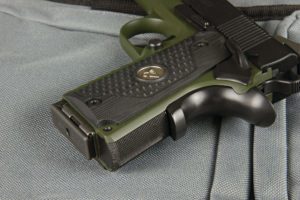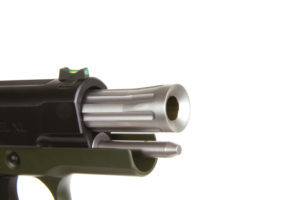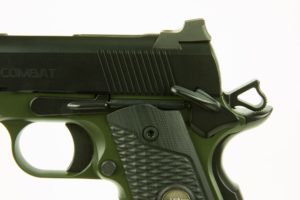Wilson Combat's new Sentinel XL is a small 1911 with an aluminum frame and shortened barrel and grip for discreet concealed carry. (Photo: Doug Larsen)
Wilson Combat of Berryville, Arkansas is well known as a maker of high end, handsome firearms with custom features. They are expensive, but with good reason. The work that goes into making a firearm with the fit and finish characterized by Wilson is extensive, and the gunsmiths that do the work don't come cheaply.
Wilson Combat is probably best known for its line of 1911 pistols that have been used by hobbyists and experts alike for years. But carrying a full sized 1911 is not for everyone because of its size and weight.
Wilson recently introduced the Sentinel XL, a small 1911 with an aluminum frame and shortened barrel and grip that make it easier to carry discreetly beneath clothing. Experienced carriers know a handgun's grip is what usually ruins the drape of clothing and makes it obvious a person has a gun.
Wilson dramatically shortened the grip on the Sentinel XL while leaving enough length so that many shooters still have a place for the little finger to grip the gun. And it's available in 9mm Luger which is growing in popularity. In fact, many who carry the 9mm are experienced gunfighters, were loyal .45ACP users, but have switched.

Wilson dramatically shortened the grip on the Sentinel XL while leaving enough length so many shooters still have a place for their little finger to grip the gun. (Photo: Doug Larsen)
Comparison
Retail customers run the gamut from very knowledgeable about firearms to beginners filled with lies and untruths fed to them by various sources, especially television, movies and uninformed web writers and net dwellers. But customers who know about such things may compare the Sentinel XL to the Officer's ACP, a 1911 produced by Colt back in 1985.
The short lived Officer's ACP was discontinued by Colt after only six years, but had features that created a following. The gun weighed 34 ounces, had a 3.6 inch barrel, a height of about five inches, and the magazine held six rounds of .45ACP. By comparison, the Sentinel XL has a 4 inch barrel, weighs 27.49 ounces, and the magazine also holds six rounds of .45ACP. The company states the height is 4.8 inches.
Some may argue that the gun is closer in resemblance to the CCO which is a 1911 sporting a 4.25 inch barrel and an Officer's length grip. In any case, the Sentinel XL fills a need for a lighter weight and smaller 1911 that is more suited for carry than the full size version. But there is a lot more to this gun.

The Sentinel XL has a black beavertail grip safety with a palm bump to ensure activation, especially when the shooter rests his thumb on top of the thumb safety while firing. (Photo: Doug Larson)
Details
The test gun is chambered in 9mm, but Wilson offers the model in .38 Super as well as .45ACP. Magazine capacity in 9mm or .38 Super is eight rounds, two more than the .45ACP.
The gun is offered with extra thin black cherry grips, but the test gun came with very attractive thin, G10 black grips from VZ Grips, both inlaid with pewter Wilson medallions. The checkering on them is aggressive which, along with the 30 LPI front strap checkering and 30 LPI mainspring housing checkering, anchor the gun firmly in hand.
The test gun's frame is finished in OD green Armor Tuff that compliments the black Armor Tuff finish on the slide and controls. Other colors are available. Two stainless steel magazines are supplied and have steel baseplates making them almost indestructible when dropped on a hard surface during a speed reload.
The black beavertail grip safety has a palm bump to ensure activation, especially when the shooter rests his thumb on top of the thumb safety while firing. The beavertail prevents hammer bite that some shooters otherwise might get from the skeletonized hammer. Below the grip safety is the aluminum mainspring housing that is stippled on its beveled bottom corner to add just a bit more texture for a firm grip. The thumb safety is large enough to engage easily, but not so large that it is likely to be activated accidentally.
Wilson uses a magazine release with fine checkering and rounded edges that when pressed, permitted magazines to drop freely away from the beveled magazine well. The slide catch has rounded edges and the shaft is slightly shorter than a stock catch so that it does not protrude from the right side of the frame. However, the hole on the right side of the frame is countersunk to permit field stripping by pushing the catch from right to left with a finger. No tool is required.
Instead of a skeletonized trigger that is often seen on 1911s, there are no lightening holes in the one on the Sentinel, although it has a long reach instead of a short one. As one would expect from Wilson, the aluminum trigger is excellent with a slight bit of take-up, a surprise break at just over four pounds and no discernible overtravel.
The ejection port is lowered a flared – something that is standard these days, but was extra when stock 1911s had to be customized for reliability – and the carbon steel slide has cocking serrations at the rear on both sides. There are none at the front. The front of the slide is narrowed a bit which is attractive and also probably aids in holstering the gun. Wilson calls this its carry cut. And instead of the standard radius where the front of the slide narrows downward into the recoil spring housing, Wilson makes a ball end mill cut with a tighter radius that has a slightly different appearance that some find pleasing.

The muzzle has what Wilson calls a reverse crown which is a bevel to protect the crown from damage. (Photo: Doug Larson)
Atop the slide is Wilson's Battlesight rear sight with a serrated rear, U notch and vertical front cut to aid in one-handed manipulation of the slide. There are no dots on the rear sight, but the front sight is a green fiber optic that immediately draws the eye when aiming. The top of the slide is flat with 30 LPI longitudinal serrations to reduce glare, and the bottom edges of the slide have Wilson's Heavy Machine Chamfer to reduce the possibility that the slide will cut a finger when the shooter utilizes a high thumb grip.
The back of the slide does not escape the special Wilson treatment and sports 40 LPI serrations to match the back of the rear sight and to reduce glare. Cutting the serrations is very fine work and is done expertly as evidenced by the way the serrations on the back of the slide blend perfectly with the serrations on the back of the extractor.
Wilson puts a 4-inch fluted stainless steel match grade barrel with a flared muzzle in the Sentinel XL. The flutes might aid a bit in cooling the barrel, but Wilson says their purpose is to provide a place for debris to accumulate and not cause a malfunction. The outside of the chamber is also fluted for the same reason.
The muzzle has what Wilson calls a reverse crown which is a bevel to protect the crown from damage. It looks nice and when the gun is in battery, there is virtually no movement between the muzzle and slide.
Disassembly
With a full length guide rod, disassembly of the Sentinel XL requires that a bent paperclip or other piece of wire – one comes with the gun – be inserted in a hole in the guide rod after locking the slide back. Then the slide is eased forward so it captures the wire allowing the slide catch to be removed. Next the slide is separated from the frame after which the recoil spring, retainer and rod are removed as a unit. The barrel is then separated from the slide.
The flat coiled recoil spring used by Wilson is supposed to last for 10,000 or so rounds before it must be changed. That is substantially more rounds than a round wire spring which, depending on who is asked, has a life of 2,000 or 3,000 rounds.

The back of the slide does not escape the special Wilson treatment and sports 40 LPI serrations to match the back of the rear sight and to reduce glare. (Photo: Doug Larson)
At the Range
Wilson recommends a 200 round break in period for the Sentinel XL. During that period with the test gun there were four failures to feed hollow point ammunition due to stubbing on the feed ramp. Full metal jacket round nose ammunition never failed though. Recoil, even though the gun is a subcompact, was very manageable. Although the grip is shorter than that of a full size 1911, it's still long enough that the little finger of many shooters still has purchase. That helps control recoil.
The test gun's accuracy was very good whether shot from a rest or off hand. The gun is certainly more accurate than is absolutely necessary in a defensive handgun and the gun is capable of shooting more accurately than most shooters can manage.
Wilson Combat offers three dealer discount programs where the greater the dealer purchase, the greater the discount on merchandise. Although Wilson Combat guns are more expensive than guns offered by most manufacturers, and appeal to those customers who want a high performance, custom firearm, many retailers have customers who fit that category. And pleasing them with a quality gun often leads to repeat sales.
For more information, contact Wilson Combat at 800-955-4856 or visit wilsoncombat.com.
More top picks from Shooting Sports Retailer:
Best tips for your computer's security and retail safety
Review: Browning .380 Auto Black Label Pro
First Look: CMMG's new ultra-compact BANSHEE lineup
Hiring range instructors: In-house or on a contract?
When it's raining lead, these rugged steel targets perform






